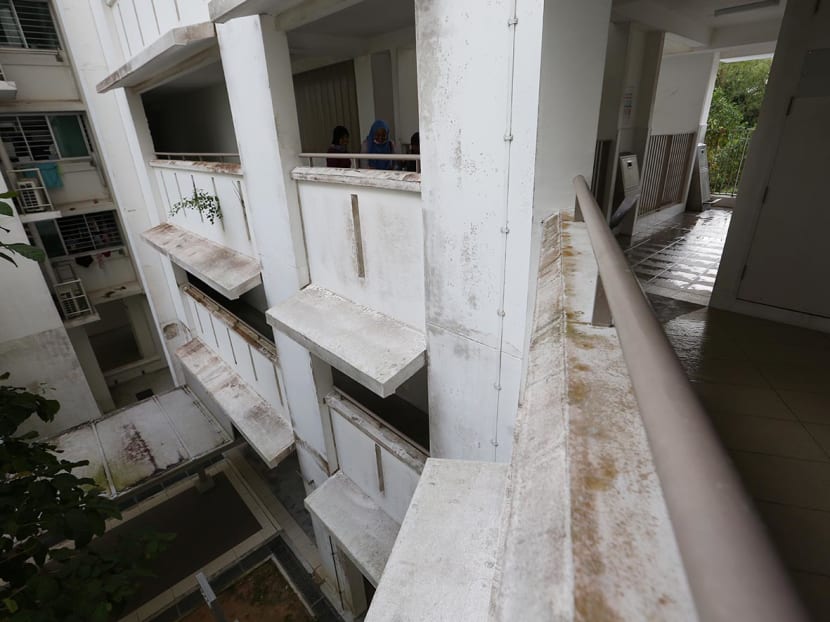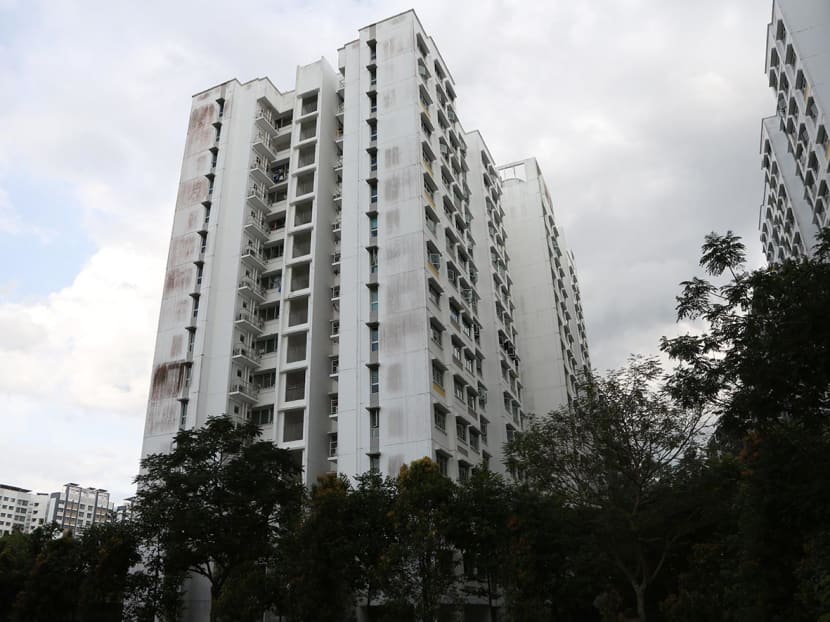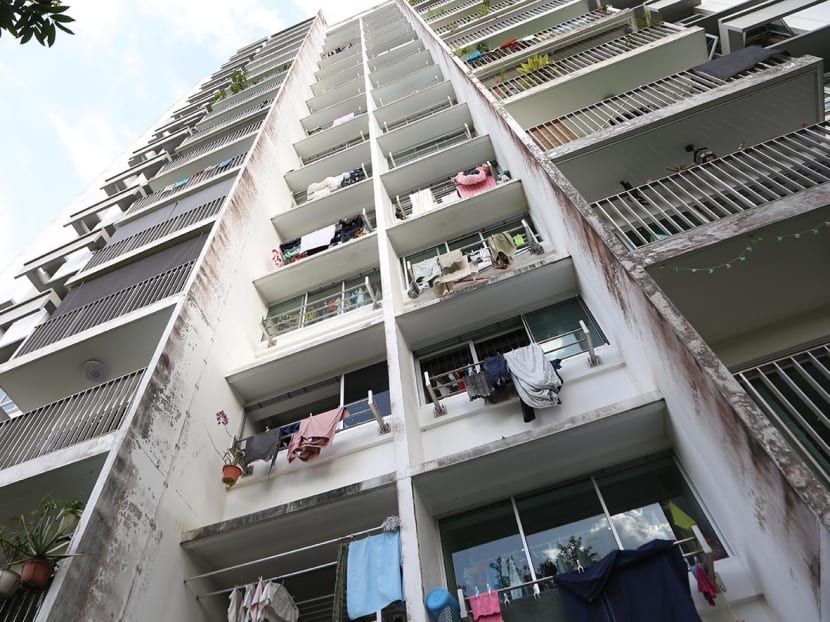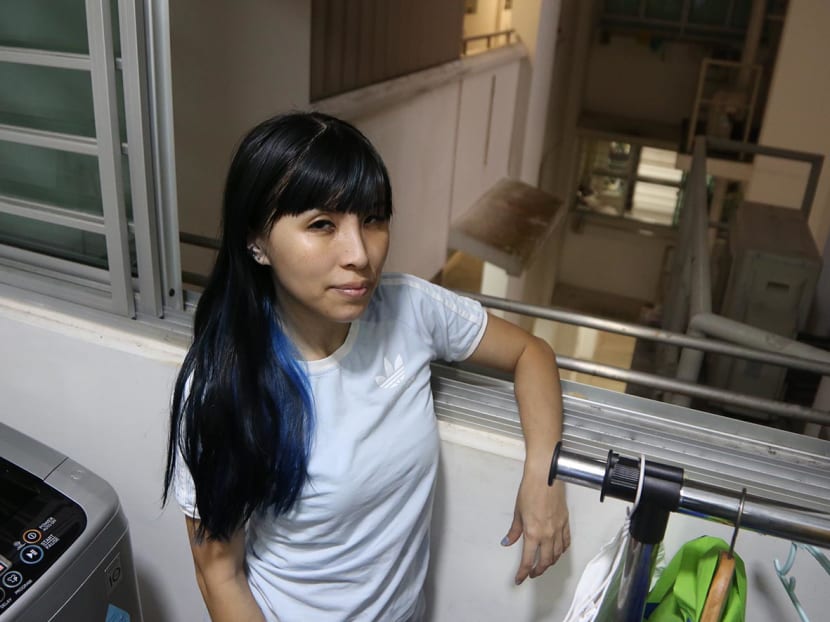Mould-stained Sengkang flats: Plans ahead for estate to undergo repair works, town council says
SINGAPORE — In response to a recent and widely circulated online complaint about the mouldy state of Anchorvale Parkview's housing blocks, Sengkang Town Council said that the Housing and Development Board (HDB) estate is scheduled to undergo repair and redecoration works this coming financial year.

Mould seen on a public housing block along Anchorvale Crescent on Jan 6, 2023.
- A Facebook user complained about the mould-stained facade of public housing blocks in the Anchorvale Parkview estate
- Sengkang Town Council said that the area is scheduled for repainting in the coming financial year and is trying to speed up the process
- Some residents also have to combat mould within their flats
- A building expert said that he cannot tell for now why mould seems to grow a lot faster at Anchorvale Parkview than other places
SINGAPORE — In response to a recent and widely circulated online complaint about the mouldy state of Anchorvale Parkview's housing blocks, Sengkang Town Council said that the Housing and Development Board (HDB) estate is scheduled to undergo repair and redecoration works this coming financial year.
The town council, which is run by the Workers' Party and looks after estate management matters there, told TODAY on Friday (Jan 6) that the call for tender for the repair and redecoration works at the neighbouring Anchorvale Cove cluster was closed on Dec 31, 2022 and a similar preparation for Anchorvale Parkview is ongoing.
"We are working to see if the process can be expedited,” it added.
The state of the outer facade of Anchorvale Parkview's housing blocks was made known on Facebook on Wednesday.
A resident, who goes by the name “Jane Wendy” on Facebook, described how the block where she lives that is about five years old looked worse than a 30-year-old building.
In her message accompanying some photos showing the state of the buildings, she said that her son continued to have “eyes allergies” and “nose issues” on top of having asthma and chronic hives, despite her efforts to dehumidify her home.
She said that there is no mould inside the flat.
The town council told her to wait for two more years until the housing blocks are given a fresh coat of paint, she added.
TODAY has reached out to the resident for more comments.


On visiting the estate on Friday, TODAY saw mould on the exterior walls of the housing blocks there.
The town council offered an explanation: This may have been a result of paint oxidation emerging from the humid conditions of the estate’s surroundings.
It said that it takes into consideration the feedback provided by the residents and “endeavours to improve on the quality of paint used at the next repair and redecoration of the estate”.
MOULD WITHIN THE FLATS
Five residents out of the 10 who spoke to TODAY on Friday said that they were not disturbed by the mould on the exterior walls.
All but one of them have lived there since the Build-to-Order housing development was completed around 2017. The housing units at the estate have just recently passed the required minimum occupancy period before owners may sell the flats.
In some cases, though, mould is persistently appearing indoors as well.
A resident who wanted to be known as just Ms Lim, 33, said that the mould in her master bedroom was so bad that she had repainted it twice in fewer than five years, with dampness felt on the wall and mould growing within a year after repainting.
She said that she has exhausted all ways to minimise the problem, such as by frequently ventilating the room, using anti-mould paint and by not using the air-conditioner to prevent possible water vapour condensing on the cooled walls.
She has heard of a few other neighbours who have had mould in their flats.
“I think it might be a structural thing, not just an exterior paint maintenance issue,” she suggested.
Two other residents also have mould forming on the walls within their homes.
Mr Alvin Mah, 36, said that HDB assigned a worker to help him repaint the house one time after he complained about it, while Mr Mohd Ramadan, 33, said that he repainted the walls himself.
TODAY has reached out to HDB for comments.
Mr Mah described the state of the blocks as “disappointing”.
He said that an old housing estate where his mother has lived for more than 30 years was better maintained and looked better than his, though he did not want to say where that was.
Mr Ramadan said that the mould, if left untreated, might work its way through the layer of paint that protects the building.
“Over time, we might face problems like water seepage and so on,” he added.
For Ms Iris Tan, a 31-year-old freelance content creator, she hangs her clothes indoors sometimes or else she takes her laundry to the laundromat about three times a week to dry her clothes.
She does not want to hang them out the windows because the exteriors frequently get mouldy and rusty even after being cleaned.


Ms Tan also said that she hardly opens the service balcony's window due to an unpleasant “damp” smell that wafts through her flat.
Commenting on the mould-stained appearance of the housing blocks, Mr Boey Ngai Heng, 50, said that it is to be expected due to the humid weather in Singapore.
“Every few years, the town council will paint the blocks new, so no need to worry,” he added.
A 32-year-old resident who wanted to be identified as just Ms Wong said that she had noticed some mould since the second year she lived there, but shrugged it off as the “natural ageing” of the buildings.
Even though she knew that mould could potentially be linked to certain medical problems, her two toddlers aged two and three years have not had any health concerns related to the fungal growth.
Ms Jasmine Lai, 35, a resident of the neighbouring Anchorvale Clove estate, said that she was shocked by the mouldy condition of the blocks at Anchorvale Parkview.
This was especially considering that they are close to each other and both areas are managed by the same town council.
Some residents acknowledged that they did think about whether the way the blocks look now might leave a negative impression on potential buyers, but this was not a major problem.
“It’s a potential concern, but not a big one because I don’t have plans to sell anytime soon,” Mr Mah said, for instance.
On her part, Ms Lim has observed a number of her neighbours moving out recently, so she is “not really worried” about the sale potential of flats there since some residents have managed to sell and move elsewhere.

Earlier on Friday, Dr Jamus Lim, Member of Parliament in charge of the area, wrote a comment on Facebook addressing the complaint raised by Facebook user Wendy Jane.
He acknowledged that the state of the block is “poor” and “does look older than it should”.
Dr Lim said that he was not a building expert, but he was told that the choice of paint and the location of the building beside a river may be contributing factors.
“We are working out a plan to accelerate the repair and redecoration works for this cluster,” he said, though necessary procedures such as the designing of the project and calling for open tender would mean that the matter “might not be addressed instantaneously”.
Speaking to TODAY, engineer Chong Kee Sen, who is emeritus president of the Institution of Engineers in Singapore, said that mould is “always a challenge” for humid places such as Singapore.
“It could happen to any other building,” he said, though he added that he was not able to ascertain, without more information on hand, why the mould seems to grow a lot faster at Anchorvale Parkview than some other places.








